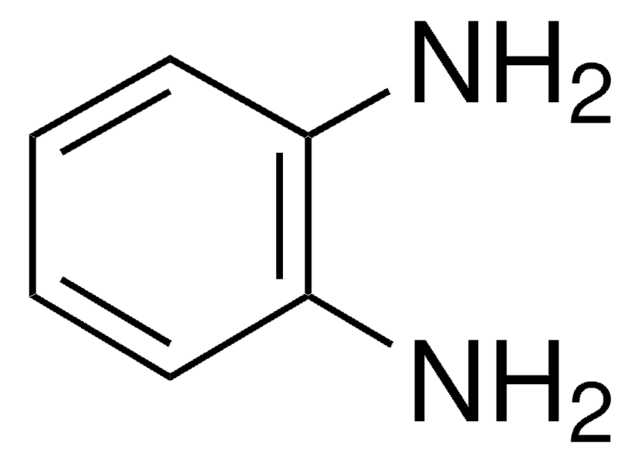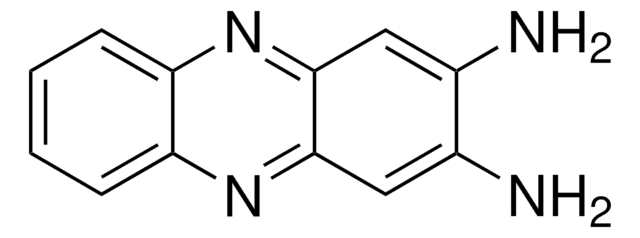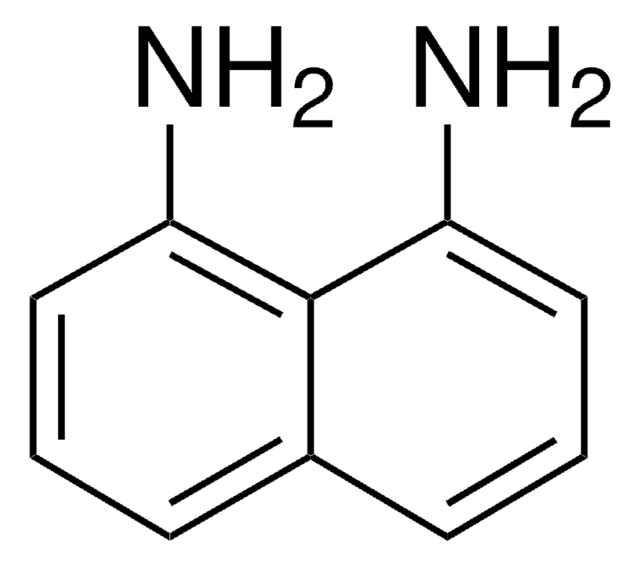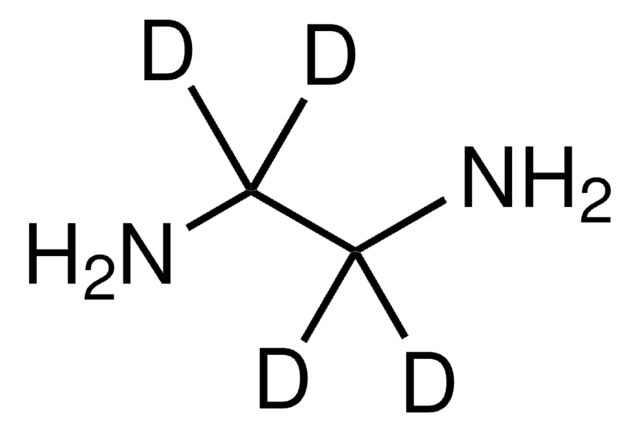Kluczowe dokumenty
E26266
Ethylenediamine
ReagentPlus®, ≥99%
Synonim(y):
1,2-Diaminoethane
About This Item
Polecane produkty
agency
suitable for EPA 300
Poziom jakości
gęstość pary
2.07 (vs air)
ciśnienie pary
10 mmHg ( 20 °C)
linia produktu
ReagentPlus®
Próba
≥99%
Formularz
liquid
temp. samozapłonu
716 °F
granice wybuchowości
16 %
współczynnik refrakcji
n20/D 1.4565 (lit.)
bp
118 °C (lit.)
mp
8.5 °C (lit.)
rozpuszczalność
H2O: soluble at
gęstość
0.899 g/mL at 25 °C (lit.)
grupa funkcyjna
amine
ciąg SMILES
NCCN
InChI
1S/C2H8N2/c3-1-2-4/h1-4H2
Klucz InChI
PIICEJLVQHRZGT-UHFFFAOYSA-N
informacje o genach
human ... FNTA(2339)
Szukasz podobnych produktów? Odwiedź Przewodnik dotyczący porównywania produktów
Powiązane kategorie
Opis ogólny
Zastosowanie
DAE can also be used in the following reduction reactions:
- DAE/Borane (1:1) complex is used as a highly selective reducing agent for the conversion of cinnamaldehyde to cinnamyl alcohol.
- DAE/Li complex is used as an efficient reagent for the reduction of alkenes, aromatic hydrocarbons, phenols, and alcohols.
- Synthesis of nucleus pulposus (NP)-like collagen-glycosaminoglycans (CG) core.
- Surface modification of epoxy-activated cryogel.
- Alteration of the surface of carbon nanoparticles (CNPs) to generate CNPs-ethylene.
- Surface modification of triazolate-bridged metal-organic framework.
- As a solvent in the synthesis of ZnS (zinc sulfide) and ZnSe (zinc selenium) precursors by solvothermal process.
- As a reactant in the synthesis of Pd/C-ethylenediamine complex catalyst.
- As a chelating agent in the synthesis of β-Co(OH)2 nanocrystals.
- Synthesis of ethylenediamine-templated iron arsenates and fluoroarsenates.
- As a template agent and coordination agent in the synthesis of CdS (cadmium sulfide) nanocrystals.
Informacje prawne
Hasło ostrzegawcze
Danger
Zwroty wskazujące rodzaj zagrożenia
Zwroty wskazujące środki ostrożności
Klasyfikacja zagrożeń
Acute Tox. 3 Dermal - Acute Tox. 4 Inhalation - Acute Tox. 4 Oral - Aquatic Chronic 3 - Eye Dam. 1 - Flam. Liq. 3 - Resp. Sens. 1B - Skin Corr. 1B - Skin Sens. 1B
Kod klasy składowania
3 - Flammable liquids
Klasa zagrożenia wodnego (WGK)
WGK 1
Temperatura zapłonu (°F)
100.4 °F - closed cup
Temperatura zapłonu (°C)
38 °C - closed cup
Środki ochrony indywidualnej
Faceshields, Gloves, Goggles, type ABEK (EN14387) respirator filter
Wykazy regulacyjne
Wykazy regulacyjne dotyczą głównie produktów chemicznych. Można w nich podawać ograniczoną liczbę informacji na temat produktów niechemicznych. Brak wpisu oznacza, że żaden ze składników nie znajduje się w wykazie. Użytkownik odpowiada za zagwarantowanie bezpiecznego i zgodnego z prawem stosowania produktu.
EU REACH SVHC Candidate List
Wybierz jedną z najnowszych wersji:
Masz już ten produkt?
Dokumenty związane z niedawno zakupionymi produktami zostały zamieszczone w Bibliotece dokumentów.
Klienci oglądali również te produkty
Produkty
Professor Aran (Claremont University, USA) thoroughly discusses the engineering of graphene based materials through careful functionalization of graphene oxide, a solution processable form of graphene.
Nasz zespół naukowców ma doświadczenie we wszystkich obszarach badań, w tym w naukach przyrodniczych, materiałoznawstwie, syntezie chemicznej, chromatografii, analityce i wielu innych dziedzinach.
Skontaktuj się z zespołem ds. pomocy technicznej












